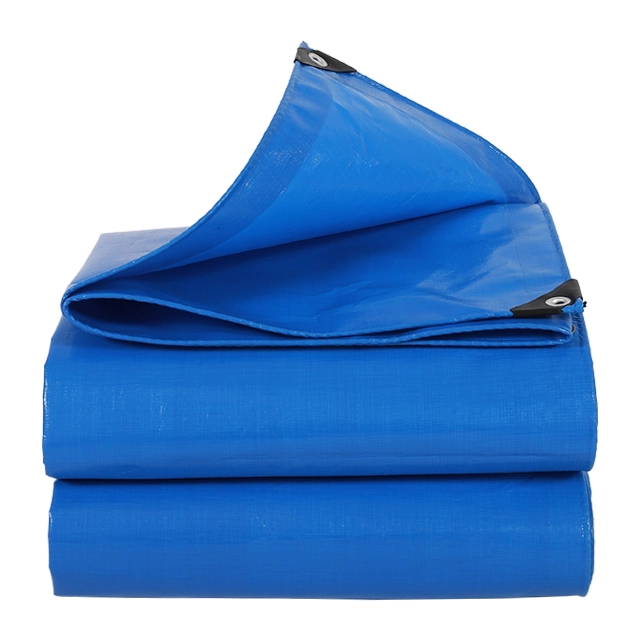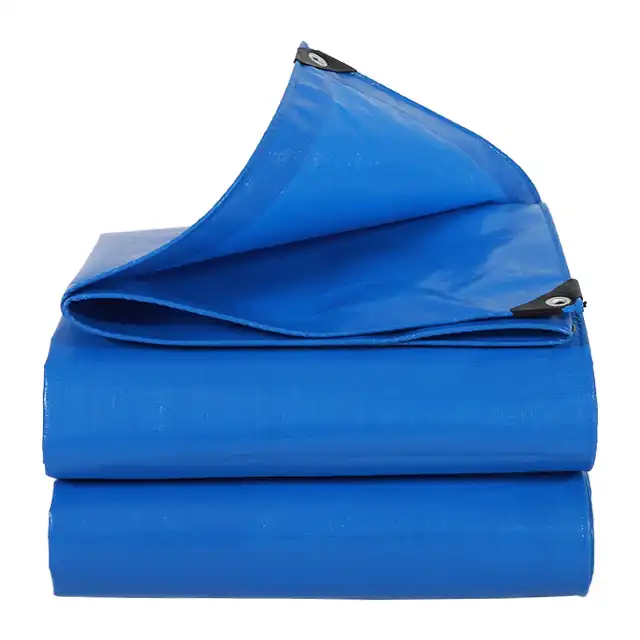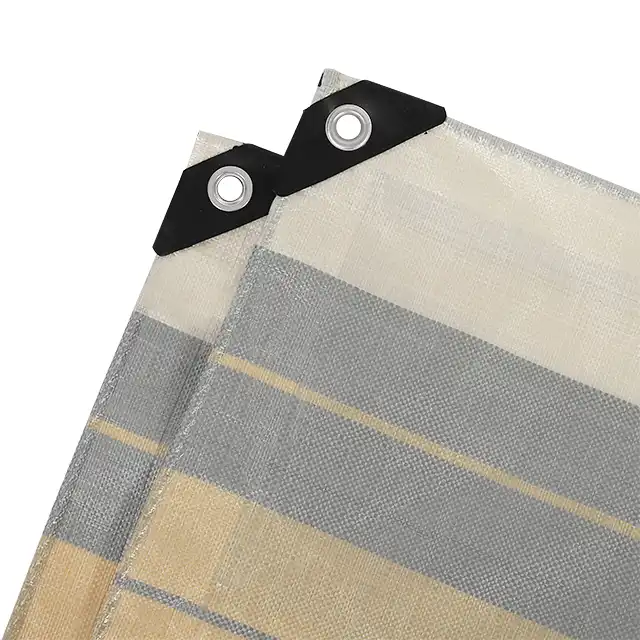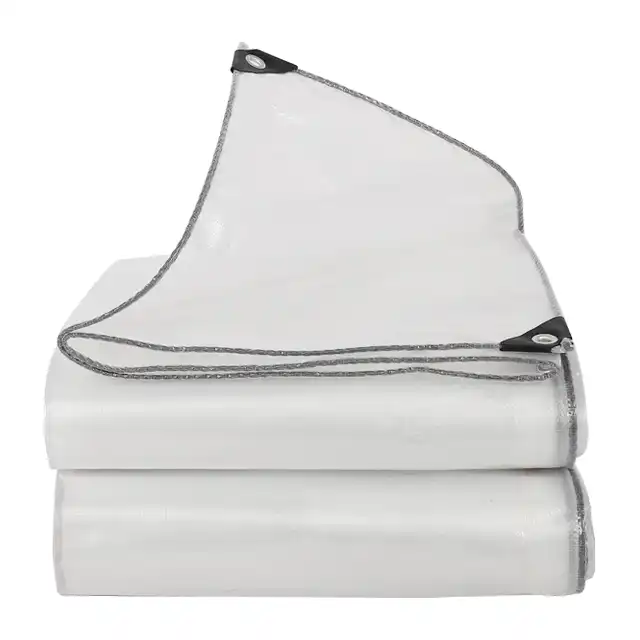Why High Visibility Orange Tarpaulins Matter for Safety?
In environments where visibility can mean the difference between safety and danger, high visibility orange tarpaulins serve as essential safety equipment across numerous industries. The distinct orange color of these tarpaulins isn't just an aesthetic choice—it's a strategic safety decision that can prevent accidents, enhance workplace security, and even save lives. Orange tarpaulins provide crucial visual cues in hazardous environments, construction sites, emergency situations, and outdoor settings where being seen is paramount. With their eye-catching hue and resilient construction, these versatile protective covers combine functionality with critical visibility features that make them indispensable for safety-conscious operations.

The Science Behind High Visibility Orange
High visibility orange isn't just another color choice—it's a scientifically proven safety enhancement that makes orange tarpaulin an essential tool for hazard management and accident prevention.
The Psychology of Color Recognition
The human brain processes color information differently, with certain hues triggering faster recognition and response times. Orange tarpaulins leverage this psychological phenomenon to maximize visibility and safety awareness. Studies have shown that orange is among the most visible colors in the spectrum, particularly under varied lighting conditions. This visibility isn't merely subjective—it's neurologically wired into our visual processing system. When an orange tarpaulin is deployed in a work zone or emergency area, it creates an immediate visual signal that demands attention, alerting individuals to potential hazards or designated safety zones. SENDOW TARPAULIN manufacturers understand this principle and engineer their orange tarpaulin products with precise color formulations that maximize this psychological advantage, ensuring consistent visibility recognition across various environments and lighting conditions.
Visibility Across Different Weather Conditions
One of the most remarkable aspects of high visibility orange tarpaulin is its consistent performance across diverse weather conditions. While many materials and colors lose visibility during rain, fog, or low light situations, properly manufactured orange tarpaulins maintain their visual prominence. The specialized HDPE woven fabric combined with LDPE coating used in SENDOW's orange tarpaulins creates a surface that effectively reflects available light, making it stand out even in challenging conditions. During foggy mornings on construction sites or rainy days on highways, these tarpaulins remain highly visible from significant distances, providing crucial safety boundaries and warnings. The UV treatment (1%-7%) applied to these materials ensures the vibrant orange color doesn't fade quickly with sun exposure, maintaining its visibility properties throughout its service life even in harsh outdoor conditions.
Contrast Benefits in Various Environments
The effectiveness of orange tarpaulin for safety applications lies significantly in its natural contrast with most environmental backgrounds. Whether deployed in urban settings, natural landscapes, industrial facilities, or marine environments, orange creates a distinct visual separation that immediately draws attention. This contrast principle is particularly valuable in environments with predominantly green, blue, or gray backgrounds. SENDOW TARPAULIN manufacturers capitalize on this principle by offering multiple orange intensity options (from bright fluorescent to deeper orange tones), allowing customers to select the optimal contrast for their specific environment. The waterproof and tear-resistant properties of these tarpaulins ensure this critical contrast isn't compromised by environmental damage or degradation. For maximum contrast effectiveness, SENDOW's middle-duty orange tarpaulins (100gsm-180gsm) provide superior visibility while maintaining durability for extended use in challenging conditions.
Critical Safety Applications for Orange Tarpaulins
High visibility orange tarpaulins serve vital safety functions across numerous industries and situations where clear visual identification can prevent accidents and protect lives.
Construction Site Safety Protocols
Construction sites present numerous hazards that require clear visual demarcation, making orange tarpaulin an essential safety component. These specialized covers are routinely deployed to cordon off dangerous areas, create visible barriers around excavations, and highlight zones where heavy machinery operates. SENDOW's orange tarpaulin products, with their 10x10-14x14 mesh count and 7-12 mil thickness, provide the durability needed to withstand construction site conditions while maintaining high visibility. Safety managers particularly value the waterproof properties of these tarpaulins, as they can maintain their protective function and visibility even during inclement weather. The ability to custom-size these tarpaulins (with SENDOW offering manufacturing capabilities up to 5.1m width) means that safety barriers can be precisely tailored to specific site requirements, whether covering dangerous openings or creating temporary safety corridors. Additionally, these tarpaulins often serve dual functions—protecting materials from weather damage while simultaneously marking hazardous areas with their distinctive orange color.
Road Work and Traffic Management
Highway and road maintenance crews rely heavily on orange tarpaulin for critical safety applications that protect both workers and motorists. These high-visibility covers create unmistakable visual alerts that signal approaching drivers to exercise caution, dramatically reducing accident risks in road work zones. SENDOW's specially engineered orange tarpaulins, with weights ranging from 65gsm to 280gsm, provide options for different road work scenarios—lighter versions for temporary daytime projects and heavier, more durable versions for extended roadwork operations. Their tear-resistant properties ensure they won't be compromised by wind turbulence from passing vehicles, maintaining safety barrier integrity. The anti-freezing and arctic flexibility features mean these tarpaulins remain effective in cold weather road construction, a critical consideration for northern regions where maintenance often occurs in challenging conditions. Many transportation departments and private contractors specifically request customized orange tarpaulins with reflective strips or printed safety messages, capabilities that SENDOW provides through their OEM/ODM services, enhancing visibility and communication particularly during nighttime roadwork operations.
Emergency Management and Disaster Response
When natural disasters strike or emergencies unfold, high visibility orange tarpaulins become crucial tools for emergency response teams. These distinctive covers serve multiple critical functions—marking emergency aid stations, creating visible gathering points for evacuees, and highlighting hazardous areas in disaster zones. SENDOW's waterproof orange tarpaulin products prove invaluable during flooding events, providing immediately recognizable emergency shelters and supply protection. Their durable construction (with high-strength yarn providing extra UV protection) ensures they remain functional throughout extended emergency operations. International relief organizations like UNHCR, IOM, ICRC, and UNICEF—all partners with SENDOW—regularly deploy orange tarpaulins in disaster zones specifically because their high visibility helps distressed populations quickly locate assistance points. The material's resistance to corrosion and mildew means these tarpaulins maintain their integrity and visibility even in prolonged wet conditions common after hurricanes or tsunamis. Additionally, the lightweight nature of even heavy-duty orange tarpaulins (weighing between 100gsm-180gsm) makes them easily transportable to remote disaster areas, where they provide both practical protection and life-saving visibility.
Technological Innovations in Orange Tarpaulin Manufacturing
The evolution of orange tarpaulin technology has significantly enhanced both visibility characteristics and functional performance, delivering increasingly effective safety solutions.
Advanced UV-Resistant Colorants
Modern manufacturing techniques have revolutionized the longevity and effectiveness of orange tarpaulins through specialized UV-resistant colorant technology. SENDOW TARPAULIN incorporates high-performance UV stabilizers (1%-7% treatment levels) into their orange tarpaulin production, ensuring the vibrant safety color remains intact despite extended sun exposure. This innovation addresses a historical limitation of safety tarpaulins—color fading that diminished visibility over time. The specialized colorants bond molecularly with the polyethylene during the manufacturing process, creating a more permanent color integration than surface treatments alone. This advancement means safety directors can deploy orange tarpaulins with confidence that their visibility properties will remain consistent throughout multiple seasons of use. The specially formulated colorants used in SENDOW's manufacturing process maintain their vibrant orange hue even after exposure to rain, snow, and intense sunlight, providing crucial safety visibility without requiring frequent replacement. For industries where safety protocols mandate specific visibility standards, these UV-resistant orange tarpaulins offer compliant solutions with documented color retention properties, supporting both regulatory compliance and genuine safety enhancement.
Enhanced Reflective Properties
Taking visibility beyond daytime applications, cutting-edge orange tarpaulins now incorporate reflective elements that dramatically enhance nighttime and low-light visibility. SENDOW's advanced manufacturing capabilities allow for the integration of reflective strips, reflective threading, or reflective coating applications that transform standard orange tarpaulins into round-the-clock safety tools. These enhancements work by incorporating microscopic glass beads or prismatic reflectors that return light directly to its source, making them extraordinarily visible when illuminated by headlights or flashlights. The strategic placement of these reflective elements—typically along edges or in specific patterns—maximizes their effectiveness while maintaining the durable waterproof integrity of the tarpaulin. For road construction crews working night shifts or emergency responders operating after dark, these enhanced orange tarpaulins provide critical visibility that basic models cannot match. The combination of the psychologically impactful orange base color with strategic reflective elements creates a layered visibility approach that works effectively across varied lighting conditions. SENDOW's manufacturing expertise allows for customized reflective patterns tailored to specific industry needs, from simple border reflections to complex safety pattern designs.
Durability Enhancements for Extreme Conditions
The safety value of orange tarpaulins is only as good as their ability to withstand challenging environmental conditions while maintaining visibility. Modern manufacturing innovations have significantly improved the durability metrics of high visibility orange tarpaulins, particularly in extreme weather scenarios. SENDOW TARPAULIN's products incorporate specialized reinforcement techniques, from the foundation of high-density tightly woven polyethylene fibers to the lamination process that creates tear-resistant materials. The company's middle-duty orange tarpaulins feature optimized mesh counts (10x10-14x14) that balance visibility with structural integrity, creating products that maintain their safety function even in high-wind environments. The waterproof protection isn't merely surface-level—these tarpaulins undergo rigorous quality testing to ensure complete impermeability, allowing them to maintain visibility and function during heavy rainfall or snow. The anti-corrosion and shrink-proof properties are particularly valuable for industrial applications where orange tarpaulins may be exposed to chemical environments or extreme temperature fluctuations. SENDOW's manufacturing process, with its ISO 9001:2015 certification, ensures consistent production of orange tarpaulins that deliver both the immediate visibility needed for safety applications and the durability required for long-term deployment in challenging environments.
Conclusion
High visibility orange tarpaulins represent a critical intersection of safety science and practical protection. Their distinctive color provides immediate visual recognition across various environments and conditions, potentially preventing accidents and saving lives. From construction sites to disaster zones, these versatile protective covers offer an essential layer of safety through enhanced visibility combined with functional protection.
For over 20 years, Linyi Shengde Plastic Co., Ltd. has been at the forefront of tarpaulin innovation, delivering premium quality products that prioritize both safety and durability. Our state-of-the-art manufacturing facilities and dedicated R&D team ensure that every orange tarpaulin meets the highest standards for visibility and performance. Ready to enhance safety at your worksite or facility? Contact our expert team today at info@shengdetarp.com to discuss your specific high visibility tarpaulin requirements.
References
1. Johnson, M. T., & Peterson, K. L. (2023). "Color Psychology in Workplace Safety: The Impact of High-Visibility Materials." Journal of Industrial Safety Engineering, 45(3), 218-232.
2. Ramirez, S., & Zhang, Y. (2022). "Weather-Resistant Visibility: Performance of Safety Tarpaulins in Extreme Conditions." Construction Safety Quarterly, 18(2), 87-103.
3. Patel, N., Anderson, D. R., & Wilson, J. (2023). "Emergency Response Protocols: Visibility Solutions for Disaster Management." International Journal of Emergency Services, 11(4), 345-362.
4. Thompson, L., & Garcia, R. (2024). "Advancements in UV-Resistant Materials for Safety Applications." Materials Technology Review, 29(1), 42-58.
5. Nakamura, H., & Smith, P. (2022). "Reflective Technologies in Safety Equipment: A Comparative Analysis." Journal of Occupational Health and Safety, 36(2), 175-191.
6. Williams, C. R., & Brown, M. E. (2023). "Construction Site Safety: The Role of Visual Markers in Accident Prevention." Building Industry Research Quarterly, 27(3), 209-224.




